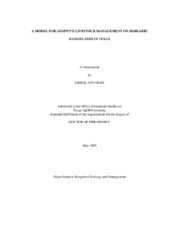| dc.description.abstract | A stochastic, compartmental Model for Adaptive Livestock Management (MALM) was developed for cow-calf enterprise for Rolling Plains of Texas from an existing model, Simple Ecological Sustainability Simulator (SESS). The model simulates forage and animal production. It runs on a monthly time step. Two stocking strategies, flexible and fixed, were evaluated at seven stocking levels for effects on forage and animal production, range condition, and net ranch income. Evaluation data were obtained from published and unpublished data from Texas A&M Agricultural Experimental Station at Vernon for Throckmorton. The model adequately simulated forage and animal production. Light fixed stocking rates and flexible stocking strategies resulted in cows of median body condition score (BCS) 5, compared to low BCS of 4 under moderate fixed stocking rate, and BCS of 3 under heavy fixed stocking. BCS declined from autumn to early spring and peaked in summer. Cows under light fixed stocking rates and under flexible stocking were heavier (460 kg) compared to those under heavy fixed stocking (439 kg). Replacement rates were lower under light stocking (22 %), compared to flexible (37 %) and heavy stocking (56 %). Calf crops were all above the reported 90 % expected for bred heifers because of the replacement policy. Flexible stocking strategy resulted in higher net income ($19.62 ha-1), compared to fixed light ($5.93 ha-1) or fixed heavy ($-17.35 ha-1) stocking strategies. Coefficient of variation (CV) in net income was highest under heavy stocking (90%) compared to light stocking (60%) and flexible stocking (50%). Maximum net income was obtained between 0.05 AUM·ha-1 and 0.13 AUM·ha-1 when fixed stocking strategy was used but when flexible stocking strategy was used maximum net income was obtained between 0.1 AUM·ha-1 and 0.17 AUM·ha-1. Range condition rapidly declined under fixed heavy stocking, increased under fixed and light flexible stocking, and remained constant under moderate flexible stocking. Heavy fixed stocking decreased range condition rapidly over a 20-year period. MALM was an effective tool to demonstrate effects of different management strategies. The model can function as a strategic or a tactical decision aid. It is concluded that there is potential for this model to assist managers in improving the sustainability of agriculture. | en |


